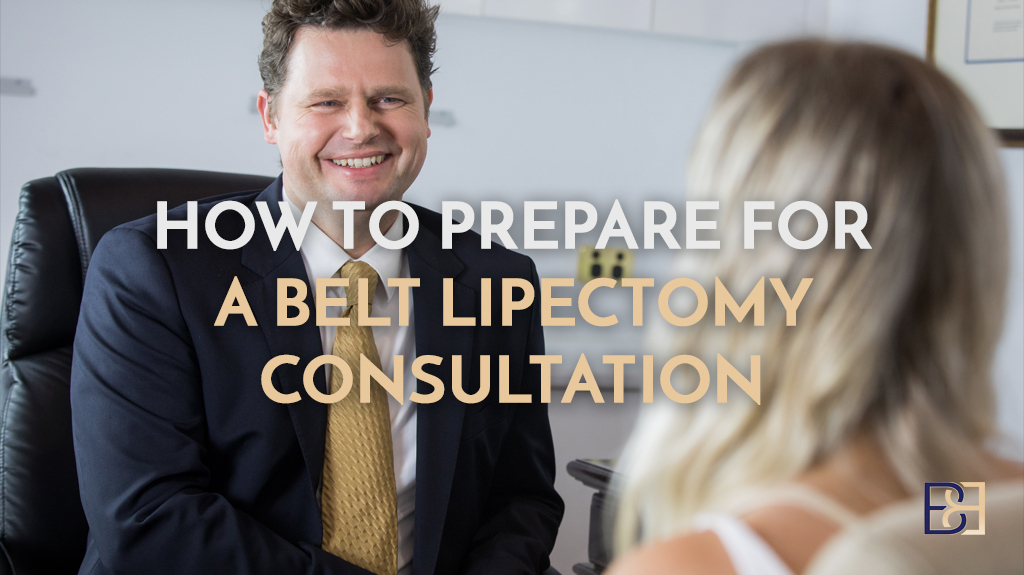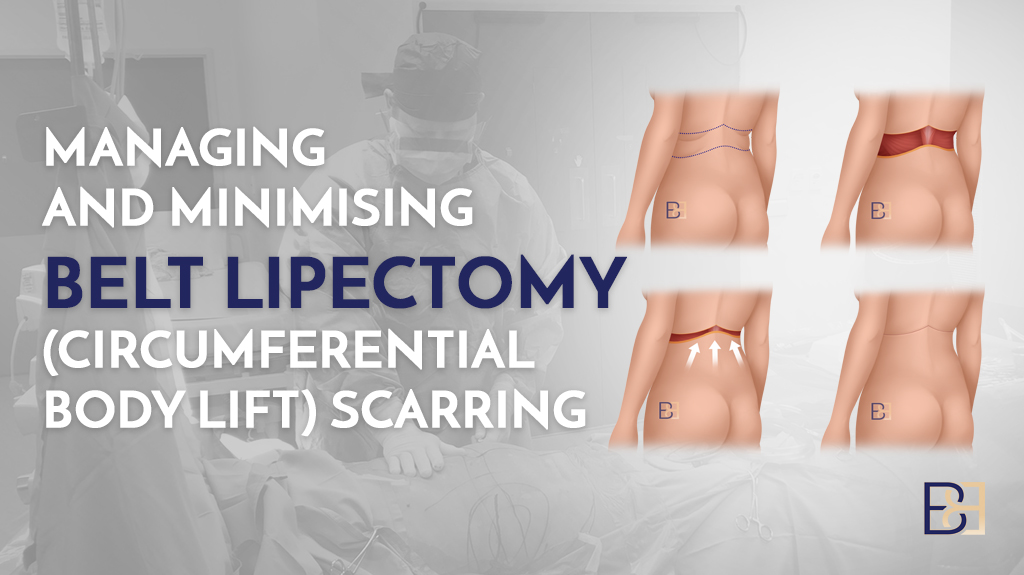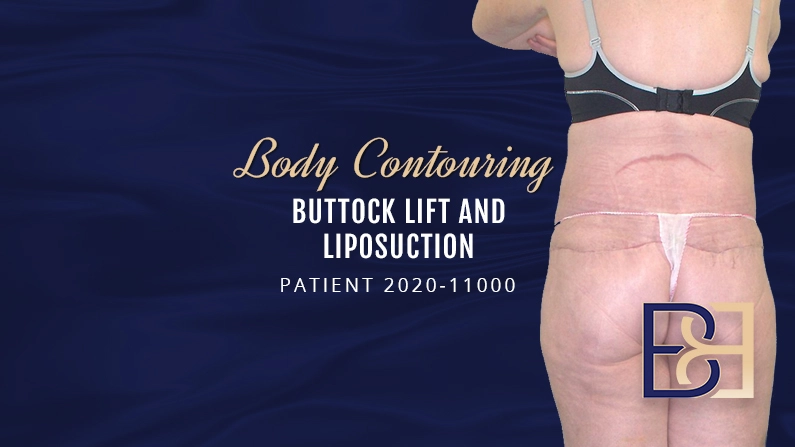From surgery to recovery, this guide covers it all. Your recovery after belt lipectomy surgery is a milestone in your weight loss journey toward tightened skin after massive weight loss. It’s good to know what to expect ahead of time so you are prepared for what lies ahead.
Let’s take a closer look at what happens during the recovery process and how to care for yourself as you heal. From leaving the hospital to resuming your daily activities, aftercare, showering, how soon you can drive, and everything in between, you’ll find it in this article.

Book your appointment online now
What is Belt Lipectomy Surgery?
Significant weight loss often results in poor skin elasticity. Loose skin 360 degrees around the waist can be removed with a belt lipectomy. Removing the loose skin is performed with a long incision all the way around the waistline. In doing so, I’m able to tighten the front, back, and sides of your midsection. Additionally, as I pull the skin up to close the incision at the waist, the skin on the buttocks, mons pubis, and thighs is naturally lifted and tightened, giving these areas a smooth look. When all is said and done, your lower torso should look leaner and firmer once all that excess skin and fat are removed.
Who is a Candidate for Belt Lipectomy Surgery?
This surgery is an excellent option for people who’ve experienced dramatic weight loss if they have excess skin folds on their abdomen, hips, lower back, and laxity in surrounding areas.
That being said, candidates for this procedure are patients who’ve reached their weight loss goals, as it should not be considered a substitute for weight loss surgery or a healthy lifestyle. While it does remove some fat, especially when liposuction is added, you’ll need to be fairly close to your ideal weight to be considered a desirable candidate. You also must keep your weight stable for at least six months before the surgery.
Desirable Candidates for Belt Lipectomy:
You might be an ideal candidate if you:
Have loose skin around your waist, hips, and lower back
Aren’t pregnant or nursing.
Don’t use nicotine products or are willing to quit.
Are dedicated to eating a balanced diet in the years ahead.
Have realistic expectations of what the surgery can and can’t do.
Are willing to follow the surgeon’s instructions to the letter.
Have lost 30+ kilos and maintained a stable weight for six months or longer.
Don’t have any serious underlying medical conditions that could make undergoing surgery too risky.
Undesirable Candidates for Belt Lipectomy:
You will not be considered be an ideal candidate if you:
Are in poor general health.
Still have a lot of excess weight to lose.
Have trouble keeping your weight stable.
Are an active smoker or unwilling to quit.
Have body image issues like body dysmorphia.
Aren’t willing to accept the possible risks of surgery.
Are pregnant, nursing, or trying to get pregnant soon.
Can’t take time off of work, strenuous exercise, driving, heavy lifting, or childcare duties to recover from surgery.
Have an active infection or compromised skin in the areas where excess skin needs to be removed.
For a complete guide to Belt Lipectomy surgery, see my article, Your Complete Guide to Belt Lipectomy (Lower Body Lift) Surgery After Weight Loss.
Benefits of Belt Lipectomy
This surgery can alter a person’s daily life in many ways. Many patients enjoy life after resolving the cosmetic and functional concerns linked to excess skin post-weight loss.
Cosmetic Benefits
A belt lipectomy aims to alter your body’s shape.
This procedure reshapes the lower torso, including the front, back, and sides of the waistline. Unlike standalone procedures like a tummy tuck (abdominoplasty), it removes surplus skin from several areas in one fell swoop. This surgery also tightens and smooths the skin on the buttocks, thighs, and mons pubic area to an extent.
Getting rid of excessive skin folds can make your midsection look less bulky in clothes.
Ultimately, the goal of this procedure is to redefine 360 degrees around the waistline for a more toned, sleeker shape.
Functional Benefits
A belt lipectomy may reduce irritation from skin folds and hygiene issues caused by excess skin.
Removing excess tissue from the lower body, including the abdomen, hips, and back can relieve chafing caused by loose skin folds. That could mean greater mobility and functionality if excess skin holds you back from normal activities. If you have chronic skin infections or rashes in areas with excessive skin, this procedure will likely resolve that for you. A lower body lift (belt lipectomy) may also tackle hygiene and body odour issues by getting rid of warm, moist skin folds where bacteria thrive.
Psychological Benefits
A belt lipectomy won’t resolve mental health issues, but it can help in other ways.
Body contouring won’t cure mental issues like depression and it’s not for people with body image issues.
Excess skin removal isn’t designed to change how you feel about yourself, but research shows it could give your self-concept a boost. (Ref 4) One study found patients who achieve a toned body through body contouring surgery following major weight loss scored higher on emotional well-being tests after the procedure. (Ref 4)

Risks and Complications
For all its possible rewards and benefits, I always tell my patients that any surgery, no matter how minor, carries risks. A belt lipectomy is a major operation that targets several body areas at once. It has slightly higher complication rates than surgeries like abdominoplasty, breast augmentation (Augmentation mammoplasty), or liposuction (Suction assisted lipectomy).
Here’s a list of some of the prevailing risks to consider before deciding whether to have surgery:
Infection
Seroma: fluid building up under the skin
Haematoma: a collection of blood pooling outside of a blood vessel
Anaesthesia risks
Asymmetry
Bleeding
Deep vein thrombosis, cardiac and pulmonary complications
Fat necrosis: fatty tissue death
Numbness or other changes in skin sensation
Persistent pain
Poor wound healing
Possibility of revisional surgery
Recurrent looseness of skin
Skin discoloration and/or prolonged swelling
Skin loss
Unfavourable scarring
This list isn’t exhaustive. During your consultation, I’ll review a list of all known complications.
Belt Lipectomy (Lower Body Lift) Recovery
By now, you have a good grasp of what a belt lipectomy is along with the possible benefits and risks. But what happens after you have surgery? That’s when your recovery journey begins. You’ll need to follow my aftercare instructions carefully. If not, you’ll have a higher chance of complications.
Recovery Timeline
Healing from belt lipectomy surgery doesn’t happen overnight. That’s something I always tell my patients up front. You’ll fare better if you know what to expect and how to care for yourself as you heal in the weeks and months ahead.
Here’s a look at what to anticipate after your surgery. Keep in mind every patient is different and your individual circumstances may vary.
Day 1
Sore, swollen, achy, and groggy: that’s what day one is about. You’ll feel tired until the general anaesthesia wears off, which can take up to 24 hours. I’ll check in with you at the hospital to let you know how your surgery went, after which you’ll spend the night in the hospital. Compression garments will help reduce swelling.
Week 1
You’ll spend a good chunk of this week in the hospital before you’re finally discharged. The good news is you won’t be bedridden during your hospital stay. Although rest is important, you should get up and walk every few hours to prevent blood clots. Otherwise, you could end up with a major complication.
Because aches and pains can make standing upright during the first ten days or so, walking bent at the waist is the way to go. The hospital staff will be there to assist if needed. Toward the end of the week, you’ll be back at home resting. Someone will need to drive you home and assist you into and out of the car. Recruit friends or family members in advance to look after you as you won’t be as mobile as you normally might be at first. They can help you get comfy, prepare meals, and take care of chores so you don’t strain yourself. Keep in mind you’ll have some bruising near the surgical area and pronounced swelling at this stage.
During the first week or two, you’ll wear a special dressing called the PICO negative wound pressure system. It consists of a soft bandage that’s attached to a battery pack. It’s designed to protect your incision and help your wound heal. Not every surgeon uses the PICO dressing, but in my experience over the last 15 years, I’ve found it to speed wound healing. Once I remove the dressing and replace it with special medical tape which can get wet, you’ll be able to take a well-deserved hot shower.
You’ll need to wear a compression garment day and night for a few weeks to alleviate swelling in the treated areas.

The PICO dressing and battery can’t get wet, so you’ll be limited to taking bird baths to freshen up during the first week or so. When I remove the PICO dressing and swap it for medical tape, you’ll be ready to have a nice, relaxing shower.
Week 2
The worst of the tenderness and aching should be behind you, but you won’t be able to return to work, exercise, or begin driving just yet. Someone will need to bring you to your follow-up appointments with me. Toward the end of week two, once the PICO dressing is removed, you can finally have a full shower. What a relief! With the worst behind you, life should start getting back to normal.
Weeks 3-5
This is when I clear my patients to return to work and start driving. You should be more active day by day, assuming you’re healing as expected. Still, it’s important not to overexert yourself. You can increase your aerobic activity, but no heavy weight lifting or strenuous exercise just yet. At this point, you’ll still have a good deal of swelling, but bruising from the surgery should be a thing of the past.
Weeks 6-8
Progress is unfolding and you are starting to see a rough idea of your results. Keep in mind that some aching and tenderness can stick around for a bit, but any serious pain should be well behind you. You can even start lifting weights and jogging unless I tell you otherwise.
Month 3
Much of your swelling should have gone down by now. As the swelling subsides, your results will start to emerge. What you see in the mirror is not your final result, but you should be able to appreciate not having loose skin hanging around your abdomen, sides, and back of your waist anymore. That’s something to celebrate.
Any numbness you had before should gradually resolve as your nerves should be mostly healed by now. Don’t be alarmed if you get occasional shooting nerve pain. This is a sign the nerve endings in your skin are repairing themselves.
Unless you’ve had a complication, you should be able to resume strenuous activities without any restrictions.
Months 6-12
Finally, nearly all of your swelling has gone away. While firmer than before surgery, your skin will no longer feel quite so hard and tight now that most of the inflammation has eased up.
Months 12-18
At long last, your final results are ready to be appreciated in the mirror. You’ve come a long way since your surgery. The surgical scar, which started out looking pretty dark in the first few months, should be lightening up.
Book your appointment online now
Recovery Guidelines
Here is what you need to know about getting back to your usual routine.
Driving
You won’t be able to drive for approximately three weeks after a belt lipectomy. You’ll need someone to chauffeur you to and from your follow-up appointments with me, so plan ahead. Remember to take it slow your first time behind the wheel. A few weeks off the road coupled with some tenderness in your midsection, can make it feel almost as if it were your first time behind the wheel. Give it a day or two, and you should feel more at ease driving yourself around.
Returning to Work
Good news: You should be back in the office within three weeks, unless you have a physically active career like a nurse or construction worker. Bad news: You’re back to work. Remember, it’s up to you whether you want to tell coworkers about your surgery.
Resuming Your Exercise Routine
Exercise is one of the keys to keeping your body in great shape after a belt lipectomy. However, don’t rush to the gym too soon after surgery. You won’t be able to lift weights or any heavy objects for four weeks or so, at a minimum. Walking can happen from day one.
In the early part of your recovery, limit your exercise routine to walking and light aerobics once I clear you. After six weeks (give or take), you should be ready to get back into the full swing of things at the gym.
Incision Aftercare
Proper incision care will lower your risk of tissue infections and raise your chance of a nice-looking scar. Keep the wound clean as instructed, and change your compression garment daily to keep it from harbouring germs.
PICO Aftercare
During the first week or two, you’ll wear a special dressing called the PICO negative wound pressure system which consists of a soft bandage attached to a battery pack. It’s designed to protect your incision and help your wound heal. Once I remove the dressing and replace it with special medical tape, you’ll be able to take a well-deserved hot shower.
Compression Garments
Compression garments are a mainstay of healing from body contouring surgery. This soft, stretchy wrap which will go around your abdomen will help the tissues that were dissected during surgery to adhere together. These garments also may alleviate swelling in the treated areas. Though you’ll need to wear the garment day and night for a few weeks, you can remove it for a few minutes if you need a break. You will need to change it daily so it stays fresh and clean. It can be washed with your other laundry, so many of my patients get two, so that one is available when the other is in the wash.
Showering

The PICO dressing and battery can’t get wet, so you’ll be limited to taking bird baths to freshen up during the first week or so. When I remove the PICO dressing and swap it for medical tape, you’ll be ready to have a nice, relaxing shower. Freshening up can do wonders for your spirits, especially after not being able to take a full shower since before your operation. It’s the small things that feel like big milestones during a belt lipectomy recovery.
Swelling
Swelling can be extreme at first due to the surgery’s invasiveness. It can take months for swelling to resolve fully. Within three to six months, any swelling that remains should be fairly minor.
Pain Management

You’re almost certain to receive pain medication in the first week or so after your surgery. After that, you can use OTC pain meds. I’ll let you know which meds to use and which to avoid in your aftercare plan.
Sleeping
Restful sleep is good for the body and soul. Though you’ll need rest to heal, I don’t want you sleeping all day, even if it is a bit challenging to move around. Keep your head propped on pillows and your waist and knees bent when you sleep in a “beach recliner position” to put less tension on the incision as you sleep.

Final Takeaway
Belt lipectomy surgery is a significant undertaking. While the recovery process can take a while and feel challenging at times, the results can be worth it and last a long time to come. This surgery is slightly riskier than other, less complex body contouring procedures, so it’s important to follow your aftercare instructions carefully. As your surgeon, I’ll be there to check up on you throughout your recovery to make sure you heal as expected. For more information, Book a consultation with me.
Resources
Bevan, Nadia, et al. “The Relationship between Weight Stigma, Physical Appearance Concerns, and Enjoyment and Tendency to Avoid Physical Activity and Sport.” International Journal of Environmental Research and Public Health, vol. 18, no. 19, 22 Sept. 2021, p. 9957, https://doi.org/10.3390/ijerph18199957.
Brown, Adrian, et al. “Pervasiveness, Impact and Implications of Weight Stigma.” EClinicalMedicine, vol. 47, May 2022, p. 101408, www.thelancet.com/journals/eclinm/article/PIIS2589-5370(22)00138-9/fulltext, https://doi.org/10.1016/j.eclinm.2022.101408.
Gordon, Rachel A., et al. “Physical Attractiveness and the Accumulation of Social and Human Capital in Adolescence and Young Adulthood: Assets and Distractions.” Monographs of the Society for Research in Child Development, vol. 78, no. 6, Dec. 2013, pp. 1–8, https://doi.org/10.1002/mono.12060.
Neel, Omar Fouda, et al. “Impact of Body-Contouring Surgery Post Bariatric Surgery on Patient Well-Being, Quality of Life, and Body Image: Saudi Arabia-Based Cross-Sectional Study.” Plastic and Reconstructive Surgery Global Open, vol. 12, no. 3, 19 Mar. 2024, p. e5666, www.ncbi.nlm.nih.gov/pmc/articles/PMC10950165/#:~:text=The%20impact%20on%20quality%20of, https://doi.org/10.1097/GOX.0000000000005666. Accessed 24 June 2024.
Price, Michael E., et al. “Body Shape Preferences: Associations with Rater Body Shape and Sociosexuality.” PLoS ONE, vol. 8, no. 1, 2 Jan. 2013, p. e52532, https://doi.org/10.1371/journal.pone.0052532.
Rand, Colleen S. W., et al. “Assessment of Socially Acceptable Body Sizes by University Students.” Obesity Research, vol. 5, no. 5, Sept. 1997, pp. 425–429, https://doi.org/10.1002/j.1550-8528.1997.tb00665.x. Accessed 13 Apr. 2020.
Alzahrani, Khalid J, et al. “A Psychosocial Analysis of the Effect of Body-Contouring Surgery on Patients after Weight Loss.” Eplasty, U.S. National Library of Medicine, 28 Mar. 2017, www.ncbi.nlm.nih.gov/pmc/articles/PMC5372753/.





